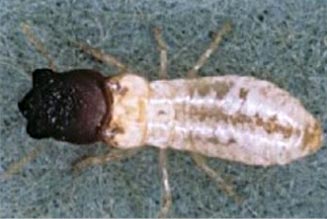

2015-06-01 Dott.sa Carla Petta posted:
SPECIES: Termite (infraorder Isoptera) (from Greek iso = equal, and ptera = wings)
COMMON NAME: Termite
LIFECYCLE: generally from August to October; during periods of high humidity, such as a rainy day, termites may swarm or take part in nuptial flights. They lose their wings during the flight. Unlike bees and carpenter ants, termites only mate after first finding a suitable location to establish their termite mound. The male does not die after mating with the queen: they becomes a real couple that will mate occasionally. Termite eggs are deposited loose and the nymphs that hatch are all identical during their first stage. At the second stage we see nymphs with small heads that will become winged individuals, while those with big heads will become workers or soldiers. The lifetime of a termite colony varies according to the fecundity of the queen.
FEATURES: termites are photophobic and have powerful masticator mouthparts. Termites are often confused with winged ants. Some differences that termites have in comparison to the winged ants are: straight antennae, short legs, two pairs of identical wings, and their thorax connection. Termite populations have two main castes: "reproductive" and the "sterile", both of which include males and females. The reproductive caste are the 'royalty' (1%) of the colony. They emerge from the nest for a pre-nuptial flight, after which they lose their wings and pair off to found new colonies as "king" and "queen". Through the laying of eggs, they guarantee the maintenance and growth of the colony. Some are derived from winged adults (dark colour) other development workers (light coloured). Size varies from 7.5 to 10 mm, depending on origin. The sterile caste instead includes "soldiers" and "workers". There are two main categories of soldiers: individuals with undifferentiated heads and large Mandibles (powerful and scissor-like, or straight, wavy or stretched, or even asymmetrically left-twisted, etc.); individuals with a prolonged head in a visibly conical process, the distal end of which contains the frontal gland duct, and a small, vestigial mandibles (called "nasutes"). The eyes are developed or reduced in primitive species, but missing entirely in the others. The soldiers are incapable of chewing wood, digging into the soil, kneading the ground and droppings, or otherwise contributing to the construction of the nest. Their function is defensive, especially against ants, the main enemies of the Isoptera, and they have mandibles that cut or disembowel. They come when the nest detects a breach; they accompany and flank the columns of scouts and foragers, or form barriers on two sides, turning their heads outwards; they form a protective circle around the aperture from which the winged termites swarm; they deploy themselves around workers, etc. The tawny-brown soldiers make up about 5% of the colony. The workers instead provide for the needs of the colony, excluding reproduction: they dig tunnels, build, repair and enlarge their nests, make covers for deliveries, go in search of food, feed other members of society, collect, and carry the brood; they raise young termites; they facilitate the exit of the winged swarms preparing, for example, special assembly rooms on the periphery and open up exits. They participate in the defence of the community by quickly raising barricades to prevent access to the nest by strangers, bite enemies, etc. The workers are 5-6 mm in size, a white-yellowish colour, and make up 90-95% of the colony.
Habitat: of the approximately 2,400 species present throughout the world, only five are present in Italy, two of which are quite widespread throughout the country and one, Cryptotermes brevis, has been sighted recently in some Italian cities. The others are of no importance at present.
DIET: Wood-eating insects: they feed on wood and digest the cellulose thanks to a population of symbiotic bacteria inside their stomach. The feeding of the entire colony occurs through Trophallaxis, where food is transferred from one termite to another either mouth-to-mouth (i.e. regurgitation), or anus-to-mouth.
DAMAGE: Termites can also colonise plants, but prefer to attack dead wood and stumps. Due to this preference, they appear more widespread in towns, where they use different methods to penetrate structures, causing expensive damage that becomes an even bigger problem if the attack is on historical and artistic heritage, be it wooden or paper. Termites attack wood used as load-bearing beams, ceilings and wooden items, furniture, fixtures, skirting boards, window and door frames, beading, and panels, as well as books, archives, etc. Once the damage has been identified, investigating the attack vectors reveals lots of small white creatures moving quickly try to hide away in those same structures where they have been hidden from view. Wood infested by termites shows no signs visible from the outside, so, in the absence of adequate prevention, termite activity ends up manifesting only when the damage is so advanced as to be very serious. Eschewing direct light, Reticulitermes lucifugus attacks the wood substrate and eats it from the inside, leaving the free surface layers, without producing any kind of hole: the continual excavation work thus normally remains hidden from view. The consumed wood assumes a peeled appearance, with large gaps intercalated in layers superimposed more or less thinly, similar to oblong slats, in the direction of the wood fibres. No amount of sawdust is ejected outside, and the walls of the holes have no frass, but are covered instead with a kind of cement made by mixing ground, cellulosic debris, droppings, and saliva.
How much it cost?